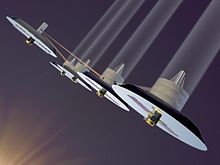Terrestrial Planet Finder
The Terrestrial Planet Finder ( TPF ) was a NASA project that was to use several space telescopes to search for Earth-like planets ( exoplanets ) in other planetary systems of the Milky Way from 2020 . In February 2006, TPF was postponed indefinitely due to budget cuts and discontinued in 2011.
development
The aim of the project was not only to find earth-sized planets in the habitable zone around neighboring stars , but also the spectroscopic analysis of their composition, i.e. the presence of water, CO and CO 2 , O 2 molecules, ozone and methane. In addition, the formation of planets from the gas and dust disks around young stars should be investigated.
According to the planning until May 2004, the project should consist of two complementary telescope systems:
- a large optical telescope with about 10 times the resolution of today's Hubble space telescope
- an infrared - interferometer from probably four interconnected infrared telescopes, each with 3-4 m in diameter.
The decisive factor here would be to use nulling or special optics ( coronograph ) to reduce the radiation emanating from the stars to such an extent (factor 10 6 to 10 9 ) that the weak radiation from planets in the vicinity of the stars can be recognized.
According to the current state of the art, the observable range would be expanded to around 45–50 light years with this project and would enable the investigation of over 150 stars in our vicinity. The start of the optical telescope was planned for around 2014, the infrared telescope should follow before 2020. From 2020 the follow-up project Planet Imager was planned, which was supposed to increase the range of the observations through a combination of several TPF systems.
The project was coordinated with the ESA Darwin project , which, however, was canceled in the conception phase in 2007.
See also
Web links
- extrasolar-planets.com - TPF
- TPF homepage (English)
